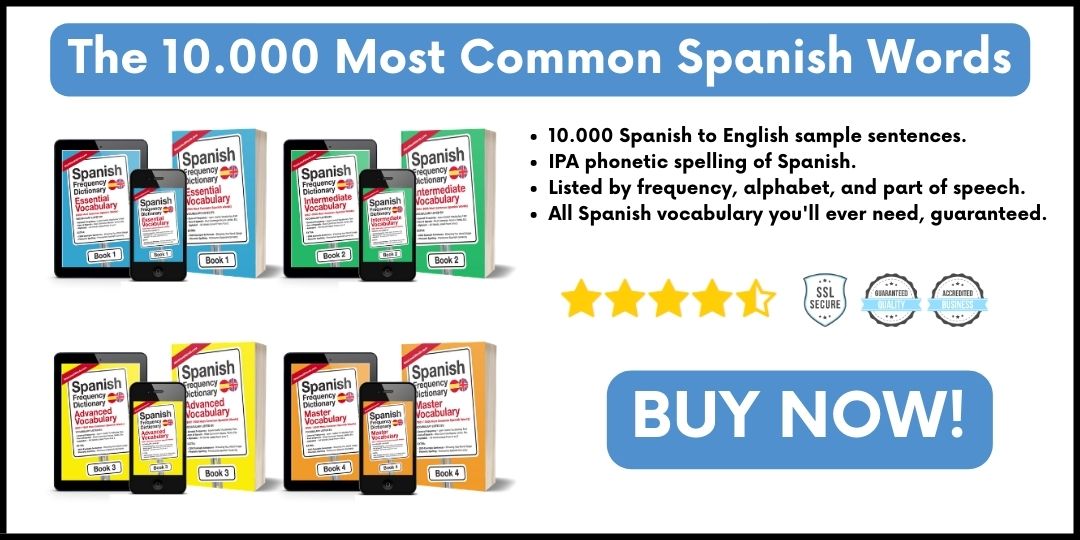How To Say "With" In Spanish
Are you struggling to say "with" in Spanish? Do not worry, you are not alone. With its various meanings and contexts, "with" can be a tricky word to translate. In this article, we will explore the meaning of "with" in Spanish, provide you with its translation, and offer five examples to help you use it correctly.
Fast track your vocabulary with the 10.000 most common Spanish words!
What is "with" in Spanish?
In Spanish, "with" is translated as "con" (IPA: /kon/). This two-letter word is used to express the idea of accompanying or being in the company of someone or something. It can also be used to express the manner in which something is done or to indicate the use of an object.
Meaning of “With” in Spanish
"Con" is a versatile word in Spanish, with multiple meanings and uses. Here are some examples:
- Accompaniment: Voy al cine con mis amigos. (I am going to the movies with my friends.)
- Manner: Cocina con amor. (Cook with love.)
- Use: Escribo con una pluma. (I write with a pen.)
It is worth noting that "con" can be combined with other words to create compound prepositions, such as junto con (Together with) or de acuerdo con (In accordance with.)
4 eBooks of the Spanish Frequency Dictionaries series by MostUsedWords
Regional Variations
Spanish is spoken in many countries, and there are some regional variations in the way people use the language. The word "with" is no exception. Here are some variations you might encounter:
- In Mexico, you may hear "junto con" or "en compañía de" instead of "con".
- In Argentina, the word "con" is sometimes pronounced as "co" in casual conversation.
- In Spain, the word "con" is often used in idiomatic expressions, such as dar con (To find) or quedar con (To meet with).
Tips for Learning Spanish
Learning a new language can be challenging, but it does not have to be daunting. Here are some tips to help you learn Spanish:
- Immerse yourself in the language: Watch TV shows, movies, and listen to music in Spanish. This will help you get used to the sounds and rhythm of the language.
- Use a language learning app: There are many language learning apps available that can help you learn Spanish. These apps are designed to be fun and interactive, making learning more enjoyable.
- Practice with a native speaker: If possible, practice speaking with a native Spanish speaker. This will help you improve your pronunciation and pick up slang and colloquial expressions.
- Learn the grammar: While it is essential to learn vocabulary, it is also crucial to understand the grammar. Spanish grammar is different from English, so take the time to study the rules and practice using them.
- Be patient: Learning a language takes time and effort. Do not get discouraged if you don't understand everything right away. Keep practicing, and you will get better over time.
You can find the paperbacks on Amazon (we have frequency dictionaries for beginners, intermediates, advanced and near-fluent students), or get the eBooks directly from us here. (They are affiliate links. That means we might get a small commission if you make a purchase after clicking these links, at no extra cost to you.)
How to Say "With" in Spanish: Sample Sentences
Here are five sample sentences you can use to say "with" in Spanish:
- Voy al parque con mi perro.
(I am going to the park with my dog.)
- A ella le gusta leer con una taza de té.
(She likes to read with a cup of tea.)
- Fuimos a la playa con nuestros hijos.
(We went to the beach with our children.)
- Él trabaja con una computadora.
(He works with a computer.)
- Bailaron con alegría.
(They danced with joy.)
Conclusion
In conclusion, learning how to say "with" in Spanish is essential if you want to express ideas of companionship, manner, or use. By using "con", you will be able to communicate your thoughts and ideas accurately and effectively. Remember that there are regional variations in the use of "con", so it is important to be aware of them and adapt accordingly. Keep practicing and incorporating this versatile word into your Spanish conversations, and you will soon be using it like a native speaker!


